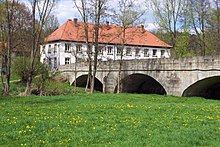Kaiserhammer
|
Kaiserhammer
Thierstein market / town of Marktleuthen
Coordinates: 50 ° 7 '26 " N , 12 ° 3' 48" E
|
|
|---|---|
| Height : | 512 m above sea level NN |
| Postcodes : | 95199, 95168 |
| Primaries : | 09235, 09285 |
Kaiserhammer is a place in the district of Wunsiedel in the Fichtelgebirge between Markt Thierstein and Marktleuthen . Kaiserhammer has been divided since the regional reform in 1978: one part is part of Marktleuthen, the other part of the Thierstein market.
history
The nucleus of the village was a hammer mill founded before 1368 by Albrecht Nothracht von Thierstein in the Reichsforst on the Eger . It was named after the Kaiser family of hammer masters, who owned the Kaiser hammer until the Thirty Years' War . 1647 Matthäus Schreyer was named as the new owner of the Kaiserhammer. In 1677 the widow Barbara Schreyer sold her extensive property to Georg Christoph Spitzbarth and Johann Thomas. Since then, the Hammergut has been divided into two halves. The Thomas sat on the Hammergut until around 1750, the Spitzbarth until around 1815. The Barsch, Raab and Zeidler families became the successors. In 1857 the hammer operation was finally shut down; the hammer mill was initially used as a glass bead factory and later as a stone cutting shop. In 1875 the village consisted of 39 buildings in which 228 residents lived. The actual Kaiserhammer, i.e. the hammer mill located to the right of the Eger and its outbuildings, has always belonged to the Thierstein market and was parish there. The Kaiserhammer hunting lodge, founded in 1701 and located to the left of the Eger, with the inn belonged to the judicial office and parish of Marktleuthen. In 1818 Kaiserhammer became part of the political municipality of Hebanz , which was renamed Schwarzenhammer in 1953 . Since the municipal reform , which came into force on January 1, 1978, Kaiserhammer has been divided between the municipalities of Marktleuthen and Thierstein.
Kaiserhammer hunting lodge
As early as the 16th century, the Selber Forest was one of the most popular hunting grounds of the Margraves of Brandenburg-Kulmbach . Initially, the hunting parties lodged in the Selb market on the edge of the forest , where Margrave Georg Friedrich had a hunting lodge built on the site of a medieval moated castle in 1580. Margrave Christian Ernst had a new, wooden hunting lodge built in 1701 under the direction of the Italian architect Antonio Porta in the middle of the extensive forest area near the Kaiserhammer.
Margrave Friedrich , also an enthusiastic hunter, commissioned the architect Johann Friedrich Graël in 1737 to renovate and expand the building, which had now become dilapidated. In 1755 the margrave decided to build a new hunting lodge in Kaiserhammer. Under the direction of the young architect Carl Gontard , a large, three-wing palace building was built in 1756 and 1757. In 1757 and 1768 a whole army of carpenters, locksmiths, blacksmiths, glaziers, flashlights and butters from the area worked on furnishing the castle and after the court plasterer Rudolf Albini had finished his work in the winter of 1759/60, it was ready for occupancy. On the occasion of a princely stay in 1761, a wooden commodity house was built near the castle. The adjacent forest was transformed into a parforce hunting garden by star-shaped aisles . A large hunting star was created , in the middle of which the prince had a hunting pavilion built in 1761. In the center of the small hunting star on the Tannenberg, a salon was built in 1762, but was not completed after the death of Margrave Friedrich in 1763. The new Kaiserhammer hunting lodge only flourished briefly. Even under Margrave Friedrich's successor Friedrich Christian , who was not interested in par force hunts, the facilities in Kaiserhammer began to decline. In 1770, Margrave Alexander ordered the buildings to be sold to private hands. However, since no buyer could be found for the actual palace building, after the land passed to Prussia, the minister in charge, Hardenberg , ordered the main wing to be demolished in 1792. The hunting pavilion on the roundabout had already been demolished and the building material obtained was used to build the bathing establishment in Alexandersbad . The former kitchen wing and stable wing are left of the buildings of the former Kaiserhammer Palace. The big Jagdstern in the Rondellwald has become a popular local recreation area; In place of the former hunting pavilion there is a mighty linden tree. The remains of the salon on the Tannenberg are known as the Schlösslein ruins.
literature
- Roland Hofmann: The hammer works on the Eger between Marktleuthen and Hohenberg . In: Self-Issues . Volume 3. Selb-Erkersreuth 1980.
- Klaus Merten: Kaiserhammer Palace and Pleasure Garden . In: Archive for the history of Upper Franconia . Volume 46. Bayreuth 1966, pp. 331-332.
- Karl Müssel : Buildings, hunts and festivals of the Bayreuth margraves in Kaiserhammer . In: Archive for the history of Upper Franconia . Volume 41. Bayreuth 1961, pp. 271-344.
- Karl Müssel: Kaiserhammer - a supplement . In: Archive for the history of Upper Franconia . Volume 46. Bayreuth 1966, pp. 333-338.
- Bernhard Hermann Röttger : District of Wunsiedel and urban district of Marktredwitz . The Art Monuments of Bavaria , VIII. Administrative Region Upper Franconia, Volume 1 . Munich 1954. ISBN 3-486-41941-2 , p. 133.
- Harald Stark : Forgotten and unknown: the Kaiserhammer hunting lodge . In: Archive for the history of Upper Franconia . Volume 91, Bayreuth 2011, pp. 125-148
Web links
- Aerial photo with the BayernViewer



